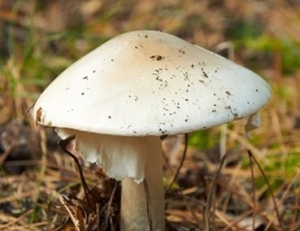
The “Death Cap” Mushroom
Amanita phalloides
Photo credit: Center for Disease Control and Prevention
Jak finally asked H’Ilgraith, “Why are you so passionate about plants?”
“I use them in soups and other potions.” H’Ilgraith explained. “I’m always searching for plants with nutritious, healing, or poisonous properties.”
“Poisonous?” Jak inquired.
“I have to know which plants or parts of a plant are poisonous,” H’Ilgraith replied. “The pulps of many fruits are rich with nutrients and good to eat, but the seeds and pits of some contain amygdalin, which is poisonous. Some mushrooms contain amatoxin, a poison that can cause death in a day,” she added. “So it is critically important to know which plants or parts of a plant are safe to eat and which are not.”
(Excerpt from H’Ilgraith.)
Introduction
March 15-21, 2020 is National Poison Prevention Week. Accidental poisonings accounted for over 75% of all poisonings reported to poison control centers in 2018 (NPDS, 2018). Just under one half of these incidents occurred in children six years of age or less. Ingestion of analgesics led the fatality rate (20%) of accidental poisonings in children six or younger.
Poisons can be swallowed, inhaled, or absorbed through the skin. Some toxic agents pose an immediate risk (e.g., insecticides) while others build up gradually (e.g., silicosis, asbestos) leading to disease long after the initial exposure (Gavrilescu, et al., 2015).
Common Household Hazards
Prescription and over the counter medicines, especially those that resemble candy. These agents accounted for approximately 23% of accidental poisonings in children (NPDS, 2018). All drugs are potential poisons. They should be kept secure.
Cosmetic and personal care products. Poisonings from these agents were most commonly encountered in children under six years of age and accounted for approximately 12% of incidents (NPDS, 2018).
Cleaning agents (e.g., chlorine and ammonia), which can be swallowed or inhaled. In the United States, calls into poison control centers for chlorine bleach ranged from 43,000 to 46,000 calls per year over a four year period (Slaughter 2019). Household cleaning agents accounted for 10-11% of incidents in children under six years old (NPDS, 2018). Adequate ventilation should be when using these products. Do not mix ammonia and chlorine bleach.
Pesticides and insecticides (e.g., organophosphates) can be swallowed, inhaled, and absorbed through the skin. Many of these agents can affect the nervous system, the heart, and the lungs. The majority of serious toxicities most commonly occur in occupational and agricultural settings. Household exposures were 3.5% in both adults and children under six (NPDS, 2018).
Carbon monoxide (CO) is a colorless, tasteless, and odorless gas that competes successfully with oxygen absorption and will accumulate to lethal levels if exposure is prolonged or left untreated (Reumuth, et al., 2019). Malfunctioning furnaces and unvented exhaust fumes from cars and generators are common sources of CO (Wu & Juurlink, 2014). Every year approximately 430 people in the U.S. die from accidental CO poisoning, and another 50,000 people are treated in the emergency room (CDC, 2020). CO monitors provide an early warning.
Poisonous plants (e.g., amanita mushrooms) lead to accidental poisoning largely because they not recognized. Ingestion can cause serious illness and may be fatal (Brandenburg & Ward, 2018.)
What To Do
For a medical emergency caused by poisoning, call EMS (911). Identify the agent, if known. If the agent is a commercial product, have the container at hand. It will have a list of ingredients. To inquire if an agent is poisonous or seek other advice, call the Poison Help Line at 1-800-222-1222. You can also access help at https://www.poisonhelp.org/help where you can enter the product name, the suspected poison, or medication and receive information regarding what to do. The American Association of Poison Control Centers https://aapcc.org/ is an excellent source of information, including steps to avoid accidental poisonings.
References
Brandenburg WE, Ward KJ. (2018.) Mushroom poisoning epidemiology in the United States. Mycologia, 110(4), 637-641.
Centers for Disease Control (CDC). (2020.) Carbon Monoxide (CO) Poisoning Prevention. https://www.cdc.gov/features/copoisoning/index.html.
Damalas, C. A., & Koutroubas, S. D. (2016). Farmers’ Exposure to Pesticides: Toxicity Types and Ways of Prevention. Toxics, 4(1), 1. https://doi.org/10.3390/toxics4010001.
Gavrilescu ,M., Demnerová, K., Aamand ,J., et al. (2015.) Emerging pollutants in the environment: Present and future challenges in biomonitoring, ecological risks and bioremediation. New Biotechnol, 32,147–156. doi: 10.1016/j.nbt.2014.01.001.
National Poison Data System (NPDS). (2018.) https://www.poison.org/poison-statistics-national.
Naughton, S. X., & Terry, A. V., Jr (2018). Neurotoxicity in acute and repeated organophosphate exposure. Toxicology, 408, 101–112. https://doi.org/10.1016/j.tox.2018.08.011.
Reumuth ,G., Alharbi, Z., Houschyar, K. S, et al. (2019.) Carbon monoxide intoxication: What we know. Burns, 45(3), 526-530. doi: 10.1016/j.burns.2018.07.006.
Slaughter, R. J., Watts, M., Vale, J. A., et al. (2019.) The clinical toxicology of sodium hypochlorite. Clin Toxicol (Phila), 57(5):303-311. doi: 10.1080/15563650.2018.1543889.
Wu, P. E., and Juurlink, D. N. (2014). Carbon monoxide poisoning. CMAJ, 186(8), 611. https://doi.org/10.1503/cmaj.130972.